How to Create a Safe Living Environment for Your Ferret

When it comes to ensuring the well-being of your ferret, there are several key strategies you can implement to create a safe living environment.
First and foremost, providing a spacious and secure cage or enclosure is essential. Ferrets are curious and energetic animals that require plenty of room to move around and explore.
In addition to a suitable living space, it’s important to offer a balanced diet that meets their nutritional needs. A diet rich in high-quality protein and fat, along with fresh water and occasional treats, will help keep your ferret healthy and happy.
Regular veterinary check-ups, vaccinations, and parasite prevention are also crucial for maintaining your ferret’s health. Establishing a good relationship with a vet who is experienced in treating ferrets can help you address any health concerns promptly.
Lastly, mental and physical stimulation are important for keeping your ferret active and engaged. Providing toys, tunnels, and opportunities for playtime outside of their cage will help prevent boredom and encourage natural behaviors.
By following these key strategies, you can create a safe and enriching environment that promotes the health and happiness of your ferret.
Ferret-Proofing Your Home
Is your ferret’s safety a top priority? Let’s make sure your home is ferret-proof! Here’s how you can keep your furry friend out of trouble:
- Inspect Your Home: Check for any potential hazards that could harm your ferret.
- Secure Hazardous Areas: Use DIY barriers or a playpen to limit your ferret’s access to dangerous places.
- Block Off Staircases: Keep your ferret away from stairs to prevent falls.
- Avoid Tight Spaces: Ferrets love exploring, but they can get stuck in tight spots.
- Protect from Electrical Cords: Cover cords or keep them out of reach to avoid chewing accidents.
- Watch out for Toxic Plants: Some plants can be poisonous to ferrets, so keep them away.
When it’s playtime outside:
- Supervise Closely: Ferrets are curious and quick! Keep an eye on them at all times.
- Secure the Play Area: Make sure your yard is escape-proof to prevent your ferret from wandering off.
- Check for Dangers: Look out for small holes, toxic substances, or other animals that could harm your ferret.
Providing Adequate Space
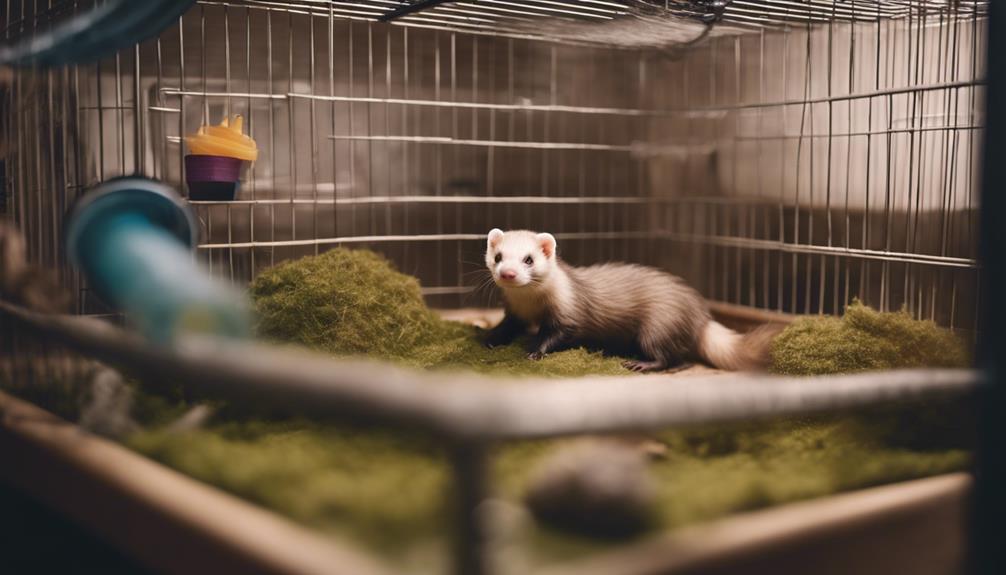
Does your furry friend have enough space to roam and play? Let’s make sure your ferret is living its best life with these tips:
- Get Creative with Space: Make the most of your space by adding shelves, hammocks, and ramps for your ferret to climb and explore.
- Playtime Fun: Set a daily play schedule outside the cage so your ferret can run around and stay active.
- Fun Cage Setup: Keep your ferret entertained in its cage with toys, tunnels, and cozy hiding spots.
- Keep Things Interesting: Keep your ferret engaged with new toys, puzzles, and obstacle courses to keep its mind sharp and prevent boredom.
Choosing Safe Bedding Materials
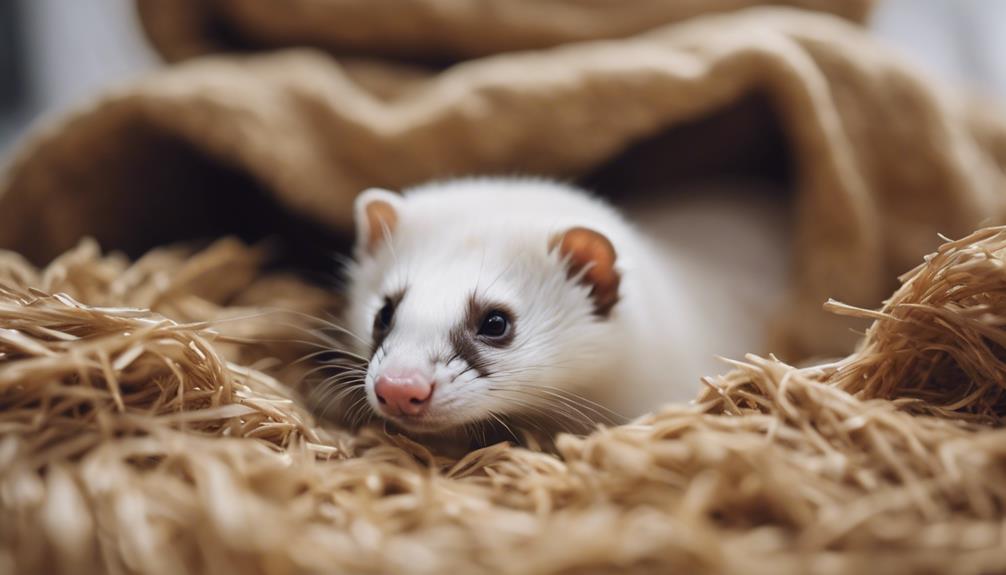
When selecting bedding materials for your ferret’s living space, it’s crucial to consider a few key points. Different bedding options offer varying levels of comfort, absorbency, and safety for your pet.
Regular cleaning and maintenance of the bedding will help ensure a hygienic environment for your ferret.
Bedding Material Options
Are you wondering what bedding material is best for your ferret? Let’s dive into the world of cozy and safe bedding options to keep your furry friend happy and healthy!
- Banish Bad Smells: Who wants a stinky cage? Choose bedding that helps control odors, so your ferret’s home stays fresh and pleasant.
- Soak up the Mess: Ferrets can be messy! Pick absorbent bedding to keep their space clean and hygienic.
- Softness is Key: Imagine walking on rough rocks barefoot. Ouch! Opt for soft bedding to pamper your ferret’s delicate paws.
- Breathe Easy: Dust can be a sneeze trigger. Select dust-free bedding to keep your ferret’s respiratory system happy and healthy.
Safety Considerations
Are you looking to keep your ferret safe and cozy in their habitat? Let’s talk about the best bedding options to create a comfortable environment for your furry friend!
- What materials should you choose for your ferret’s bedding to ensure their safety?
- Opt for non-toxic materials that are free of small particles that could be a choking hazard.
- Consider using recycled paper products, aspen shavings, or fleece blankets.
- Stay away from cedar or pine shavings, as the oils can harm your ferret’s breathing.
- What should you avoid when selecting bedding for your ferret?
- Say no to clay or clumping materials, as they can cause tummy troubles if ingested.
- Keep mold at bay by making sure the bedding is always clean and dry.
Cleaning and Maintenance
Keeping Your Ferret’s Home Clean and Safe
Hey there, ferret enthusiasts! Ready to learn how to keep your furry friend’s home spick and span? Let’s dive into some tips on choosing the best bedding materials for your ferret’s cage:
- Regular Clean-ups: How often do you clean your ferret’s bedding? It’s essential to have a routine to prevent any funky odors and keep things nice and tidy.
- Bye-bye Odors: Say no to stinky smells! Pick bedding materials that help control odors, so your ferret’s space stays fresh and pleasant.
- Check for Wear and Tear: Is the bedding looking a bit worn out? Keep an eye on it and replace it when needed to make sure your ferret is cozy and safe.
- Litter Box Location: Where’s the best spot for the litter box? Find the perfect place in the cage to encourage your ferret to use it consistently, making cleaning up easier for you.
Taking care of your ferret’s bedding is a crucial part of creating a clean and healthy environment for your playful pet. Remember, a happy ferret is a clean ferret!
Selecting Appropriate Toys
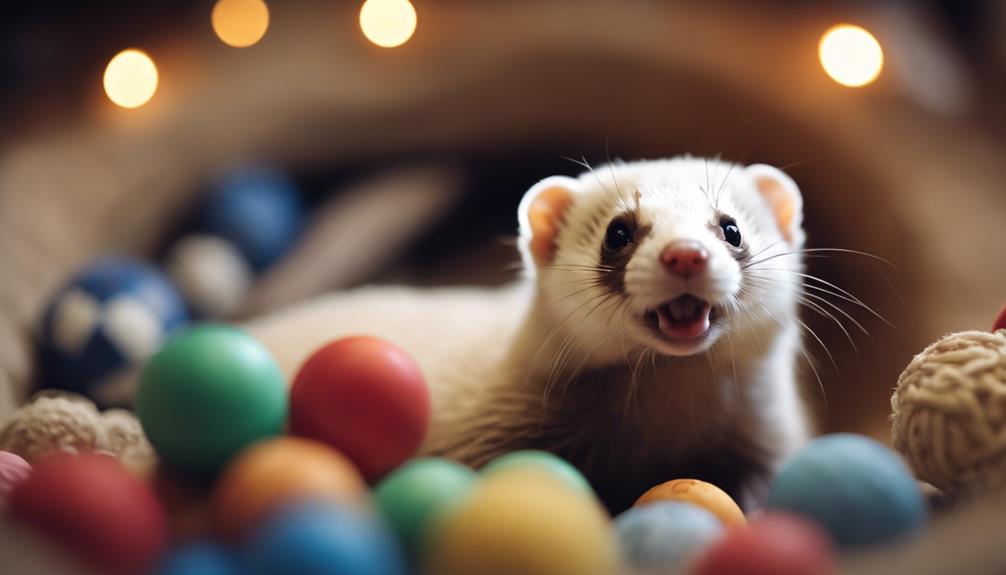
When selecting toys for your ferret, it’s crucial to prioritize toy material safety to prevent any harm or ingestion risks.
Opt for interactive toy options that stimulate your ferret’s curious nature and encourage physical activity.
Consider toys made of sturdy materials that can withstand your ferret’s playful antics without posing a danger.
Toy Material Safety
Are you making sure your ferret’s toys are safe and fun? Let’s dive into how to choose the best toys for your furry friend!
Toy Tips for Your Ferret:
- Check-Up Time: Make sure to regularly inspect your ferret’s toys for any signs of damage. This helps prevent them from accidentally swallowing small pieces.
- Safe Materials: Look for toys made from non-toxic materials. This way, if your ferret decides to nibble on them, they’ll stay safe and sound.
- Tough Stuff: Pick toys that can handle your ferret’s rough play. Sturdy toys mean more playtime fun!
- Size Matters: Avoid toys that are too small. Small toys can be a choking hazard for your curious critter.
Interactive Toy Options
Get Your Ferret Moving with Fun Toys!
Hey there, ferret friends! Are you looking for ways to keep your furry buddy entertained and active? Well, interactive toys are the way to go! Let’s dive into some cool options to engage your ferret’s natural instincts and make playtime a blast.
Interactive Toy Ideas:
- Tunnels: Ferrets love to burrow and explore, so tunnels are a great way to keep them moving and having fun.
- Balls: Rolling around a ball can be a hoot for your ferret, encouraging them to chase and play.
- Puzzles: Interactive puzzles challenge your ferret’s mind and keep them entertained while problem-solving.
- DIY Dig Box: Create a special dig box filled with safe materials like rice or uncooked pasta for your ferret to dig and burrow in.
Tips for Playtime:
- Rotate Toys: Keep things exciting by switching up your ferret’s toys regularly.
- Playtime Schedule: Establish a daily playtime routine to ensure your ferret gets enough exercise and mental stimulation.
- Variety is Key: Offer a mix of interactive toys to create a stimulating environment for your pet.
Monitoring Temperature and Humidity
Keeping Your Ferret Healthy: Temperature and Humidity Tips
Hey there, ferret lovers! Ever wonder how to make sure your furry friends are cozy and happy in their home? Let’s dive into some cool tips on monitoring temperature and humidity for your ferret’s well-being!
1. Temperature Check – What’s Just Right?
Ferrets feel best in temperatures between 60-80°F (15-27°C). Not too hot, not too cold! Extreme temperatures can stress out your ferret or even make them sick, so keep it comfy for them.
2. Humidity – The Goldilocks Zone
Aim for humidity levels between 40-60% to keep your ferret’s respiratory system in top shape. Use a hygrometer tool to get the humidity levels spot on. It’s like a weather station for your ferret’s home!
3. Let the Air Flow – Ventilation Matters
Make sure there’s good airflow in your ferret’s space without breezy drafts. It helps keep the temperature steady and prevents nasty gases from building up. Good ventilation equals a happy, healthy ferret!
4. Cozy Up – Insulation is Key
Check if your ferret’s living area is well-insulated. Good insulation keeps the temperature stable and stops heat from escaping during chilly weather. A snug home means a content ferret!
Ensuring Proper Ventilation
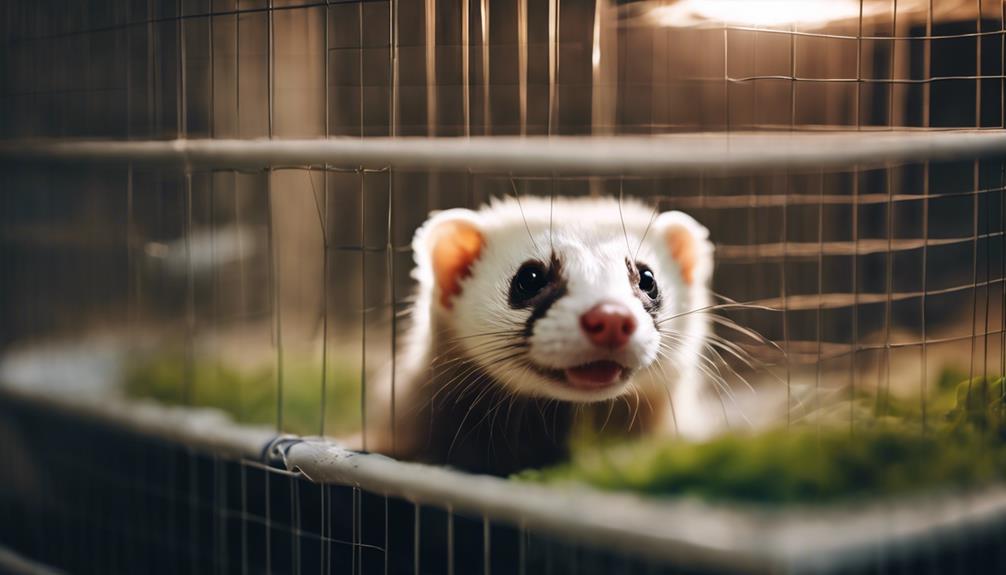
Is your ferret’s home feeling stuffy? Let’s talk about how to keep the air fresh and clean for your furry friend!
Why is proper ventilation important for your ferret’s health and comfort?
- Promotes good air circulation
- Prevents bad smells and dust from building up
Where should you place your ferret’s house for the best airflow?
- Choose a spot with good ventilation
- Avoid drafty areas, direct sunlight, and high humidity spots
How can you maintain proper ventilation for your ferret?
- Regularly clean ventilation openings
- Balance fresh air and avoid stagnant pockets
- Use a fan or open windows for better air quality
Creating a Quiet Retreat Area
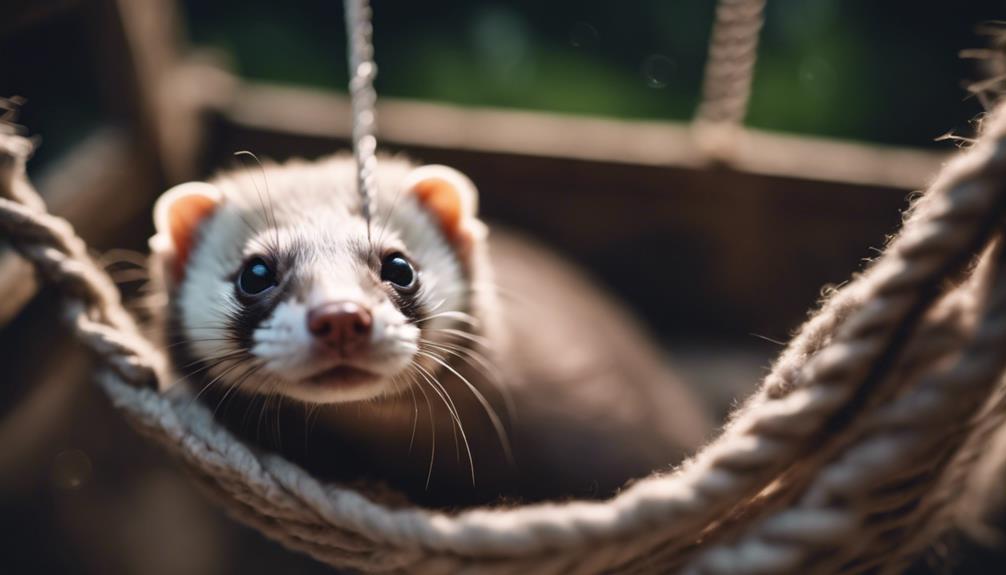
Creating a Cozy Hideout for Your Ferret
Want to give your ferret a special place to chill out and relax? Let’s make them a peaceful hideaway right in your home! Here’s how you can create a quiet retreat area for your furry friend:
- Find a Quiet Spot: Do you know where your ferret’s favorite napping spot is? Place their retreat away from loud noises and busy areas to help them feel calm and cozy.
- Comfy Bedding and Tunnels: Imagine snuggling up in a warm blanket or hiding in a secret tunnel. Your ferret will love having a soft bed or a cozy tunnel to relax in their retreat area.
- Soft Lights for a Relaxing Mood: How about adding some gentle, dim lighting to create a relaxing atmosphere? Soft lights can help your ferret unwind and feel at ease in their special hideout.
- Soothing Scents: Did you know that certain scents can help relax your ferret? Try using ferret-safe essential oils or pheromone diffusers to create a calming environment in their retreat area.
Frequently Asked Questions
Can Ferrets Be Litter Box Trained Like Cats?
Ferrets can be litter box trained like cats. While their success rate varies, many owners find it effective. Compared to dogs, ferrets adapt quicker due to their natural inclination for burrowing. Patience and consistency are key.
Are There Any Household Plants That Are Toxic to Ferrets?
Some household plants are toxic to ferrets, posing risks like gastrointestinal upset or more severe issues. Prevention involves keeping these plants out of reach. Opt for ferret-safe greenery with caution, ensuring a safe living environment.
How Often Should I Bathe My Ferret?
A ferret’s grooming routine is essential for their well-being. Bathing frequency varies based on individual needs, but generally, a bath every few months suffices. Over-bathing can lead to dry skin and irritation, so monitor shedding patterns and adjust as needed.
Are There Any Specific Dietary Requirements for Ferrets?
Ferrets require a diet high in protein and fat for optimal health benefits. It’s crucial to provide them with a balanced diet that includes meat-based foods and supplements to meet their specific nutritional needs.
Is It Safe to Have Other Pets, Such as Dogs or Cats, in the Same Household as a Ferret?
Introducing ferrets to dogs can be safe with proper supervision, gradual introductions, and training. Managing ferret-cat interactions requires caution due to cats’ predatory instincts. Always prioritize safety and provide separate spaces for each pet.











